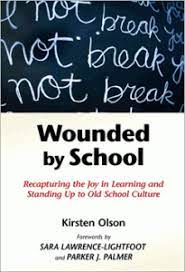Reflecting on Kirsten Olson’s Wounded by School

Written by Catherine Conner, PFF Fellow and Doctoral Candidate in English. School of Arts and Humanities.
As I read the title of Dr. Kirsten Olson’s book, Wounded by School: Recapturing the Joy in Learning and Standing Up to Old School Culture (Amazon), my first instinct was to think about students who had been wounded in overt ways such as bullying or harassment. I thought this book would help me understand the challenges students faced trying to navigate the social aspects of school hallways and playgrounds as well as the academic landscape of the classroom. In my classes, I had learned from my first-year college students that the K-12 school environment could be a place of learning and hope while simultaneously a site for anxiety and stress, and I wondered how I could help enhance the first and reduce the latter during their college experience. I discovered that Olson’s depiction of students’ wounds encompassed more than those of bullying and harassment—not only were there deeper emotional and psychological wounds, but she also discussed the ways parents, teachers, and the schools themselves were also wounded.
Olson is an educational researcher and consultant, and her writing reflects her deep concerns about children, learning, and school conditions. Wounded by School is the culmination of her research as an education doctoral candidate at Harvard; the interviews she conducted in hopes of learning about positive school experiences turned toward revelatory confessions about the pain of school experiences rather than the joy. Olson’s advisor, Sara Lawrence-Lightfoot, highlights this in the foreword to the book:
“In her first foray into the field — in-depth interviews with an award-winning architect, a distinguished professor, a gifted writer, a marketing executive — Olson certainly expected to hear stories of joyful and productive learning, stories that mixed seriousness, adventure, and pleasure, work and play, desire and commitment. Instead, she discovered the shadows of pain, disappointment, even cynicism in their vivid recollections of schooling. Instead of the light that she expected, she found darkness. And their stories did not merely refer to old wounds now healed and long forgotten; they recalled deeply embedded wounds that still bruised and ached, wounds that still compromised and distorted their sense of themselves as persons and professionals.”
I was struck by this. Growing up, I loved school. I was dutiful. I was diligent. I was not “wounded by school” (I thought). Yet what I learned from Olson’s book was that school wounds are defined in multiple ways for many students. Some of the categories were familiar: stifled creativity, demands for compliance, consequences of rebelling against assignments or the education system in general, the tedium of assessments and deadlines.
But there are subtle wounds as well that hide in plain sight: wounds of perfectionism, wounds of the average, wounds of underestimation. It is the latter three that are harder to detect and perhaps even more pervasive and long-lasting. As Olson points out, traditional schooling and its orientation toward outcomes, grades, and tangible markers of success, can create in students a fear of failure or unwillingness to take risks. Students who experience wounds of the average or underestimation have an almost opposite effect: internalizing feelings that one cannot be academically successful can lead a student to feel undervalued and unseen. I, for one, can attest to the wounds of perfectionism and the never-ending battle to achieve perfection (which fellow perfectionists know is not achievable, ironically).
Olson also includes the experiences of wounded learners who have healed to illustrate the ways parents, teachers, and students themselves can prevent and heal these wounds. She also offers key ideas to foster healing (p. 112):
- Adult supporters (even one) who tell the individual he or she is worthy and has value, in the face of the many negative messages of school.
- School environments that tend not to label and categorize children.
- School environments that provide challenges to unconventional learners; that honor and engage their unique learning gifts.
- Constant reframing of experience in the most powerful positive light
- Critical consciousness about the institution of schooling
And this changed the way I thought about education, not only for my students but for myself, and how school wounds house themselves in the mind’s operating system, subtly influencing the way one learns (in or out of the classroom) or the way one teaches. Was I perpetuating these wounds as a teacher? Was I seeing students through the lens of my own wounds? Having these questions in mind as I redesigned my courses helped me realize how I could help my students learn and heal. I modified assignments that offered students the choice to write about discuss their personal experiences, objective observations, or a mix of both. I offered them the opportunity to revise essays on their own timeline up until the end of the semester. As students learned more about writing and revising, they felt more confident in their ability to revise as the semester progressed. I also spent more time building classroom community by using small icebreakers and questions to spark conversation: What’s your dealbreaker pizza topping? What’s a new skill you’d like to learn? While not “instructional time” per se, it is time well spent to help students feel seen and connected, as well as more engaged with the class and their peers.
As educators, we bear a responsibility to our students—and maybe more importantly, to ourselves—to consider how these wounds factor into our classrooms and how we can work to heal our students’ wounds as well as our own.
Share